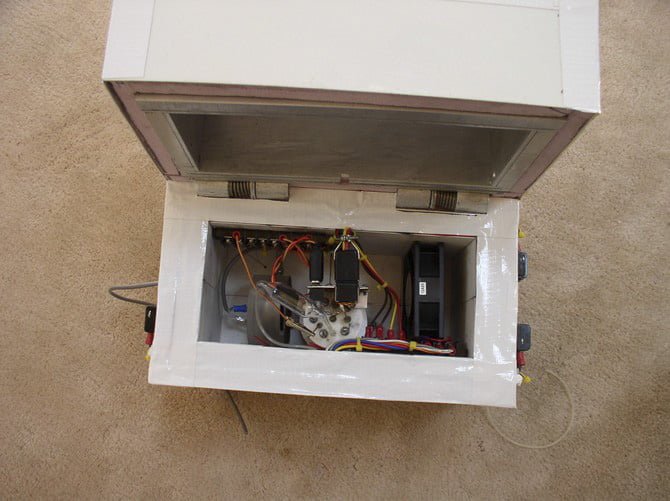Progress Report #4
PROGRESS-REPORT-4 Effect of Important Variables
INTRODUCTION
The previous Progress Reports can be read at www.LENRexplained.com. The various novel features of the calorimeter are explored in this Progress Report.
These features included measurement of OCV, loading behavior, the effect of temperature on the various behaviors, and the behavior of volume expansion resulting from repeated loading and deloading.

center, the GM detector is on the left, and the fan is on the right.
A number of Pd-Ag compositions have been made and subjected to treatments and measurements considered important to this study. These treatments include measurement of the sample volume during various stages in its treatment and subjecting the sample to various methods to improve its reaction with hydrogen.
The relationship between each of these variables and production of excess energy will be established in order to improve the reproducibility of producing this extra energy. The initial results from the study of each of these variables are described and discussed below.
RESULTS
1. Expansion behavior
As described previously(1, 2), the guide used to design this research identifies expansion of the material as result of reaction with hydrogen as being an important variable for excess power production. Because the excess power requires deuterium to be present, the sample must first react with deuterium. This reaction causes the material to expand and change shape by more than would be expected based on the known increase in lattice parameter of the beta phase. This additional volume is retained when the hydrogen isotope is removed. This shape change is proposed to produce uneven stress and formation of cracks, which allow a nuclear process to take place in the gaps when the gap is exactly right. Consequently, the amount of hydrogen able to react and the resulting uneven expansion is important to know and control.
The expansion is measured using micrometers after various treatments have been applied. An example of this behavior using pure palladium is summarized in Table 1. ….
Continue to read PROGRESS-REPORT-4
1. E. K. Storms, The explanation of low energy nuclear reaction. (Infinite Energy Press, Concord, NH, 2014), pp. 365 pages, (updated e-version available at Amazon.com).
2. E. K. Storms, A Theory of LENR Based on Crack Formation. Infinite Energy 19, 24-27 (2013).
See also:

Charles, the role of excess volume is complex and not easy to describe in a brief comment. At the basic level, the process that causes excess volume creates uneven stress in the entire sample. This stress creates cracks at the surface because this is were the stress is most intense. The resulting NAE at the surface generates nuclear power at a rate determined by how rapidly the D can move from the interior to the sites where fusion occurs . This rate is controlled by temperature. Of course, this effect of temperature only happens after the NAE forms.
As you note, temperature can cause stress that can help form the NAE, but this process is even more complex. To make the discussion understandable, each of these processes need to be examined and discussed separately, which I have attempted to do in the Reports. Right now in the lab, I trying to find out how to create the NAE with more reliability.
Although not explicitly mentioned, the likelihood of excess volume not being an issue for the passive bulk probably has a significant impact on the surface where the NAE are expected to nucleate.
Because heat is such an issue and may cause destructive conditions for the NAE, the bulk morphology still has an impact on the system scale.
The demonstration of positive thermal feedback is definitive however Ed stipulates that the NAE are stable but fails to drive the point home that stability means an all encompassing thermal profile to control the reaction and increase yield. This thermal profile includes nucleation of stable NAE. The window of operation needs to be determined.
Bravo on the creation of Report #4. Thanks